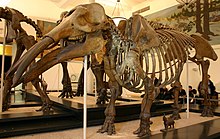Gomphotherium
| Gomphotherium | |
|---|---|

| |
| Gomphotherium productum at the AMNH | |
| Scientific classification | |
| Kingdom: | |
| Class: | |
| Order: | |
| Family: | |
| Genus: | †Gomphotherium Burmeister, 1837
|
| Synonyms | |
| |
Gomphotherium is an extinct genus of proboscid which evolved in the lower Miocene of North America. It survived from 13.65–1.7 million years ago (mya).[1]
They spread to Asia, Europe and Africa after a drop in sea level allowed them to cross over.[2] It survived into the Pliocene, and its remains have been found in Chile, china, France, Germany, Austria, Kansas, Tennessee, Pakistan, Kenya and Bosnia and Herzegovina.

Gomphotherium stood around 3 metres (9.8 ft) high with an estimated weight of 4-5 tons, and looked similar to a modern elephant.[3] However, it had four tusks; two on the upper jaw and two on the long lower jaw. Gomphotherium lived in dry wooded regions near lakes.
Feeding method
[change | change source]The lower tusks are parallel and shaped like a shovel. They may have been used to dig up food from mud. These animals probably lived in swamps or near lakes, using their tusks to dig or scrape up aquatic vegetation.
However, wear patterns on the teeth of its relative Platybelodon suggest that it used its lower tusks to strip bark from trees, and may have used the sharp incisors that formed the edge of the "shovel" more like a modern-day scythe, grasping branches with its trunk and rubbing them against the lower teeth to cut it from a tree.[4]
Unlike modern elephants, the upper tusks were covered by a layer of enamel. Compared to elephants, the skull was more elongated and low, indicating that the animal had a short trunk, rather like a tapir's. In comparison to earlier proboscids, Gomphotherium had fewer molars; the remaining ones had high ridges to expand their grinding surface.
References
[change | change source]- ↑ Wang, Wei et al 2014. Early Pleistocene large-mammal fauna associated with Gigantopithecus at Mohui Cave, Bubing Basin, South China. Quaternary International 354: 122–130. [1]
- ↑ Alberdi M.T. et al 2007. Historical biogeography of trilophodont Gomphotheres (Mammalia, Proboscidea) reconstructed applying dispersion-vicariance analysis. In Díaz-Martínez E. & Rábano I. (eds) Proceedings of the 4th European meeting on the palaeontology and stratigraphy of Latin America. Madrid: Instituto Geológico y Minero de España, pp. 9–14.
- ↑ Paleofiles. [2] Archived 2015-02-05 at the Wayback Machine
- ↑ Lambert W.D. 1992. The feeding habits of the shovel-tusked gomphotheres: evidence from tusk wear patterns. Paleobiology, 18(2): 132-147.
